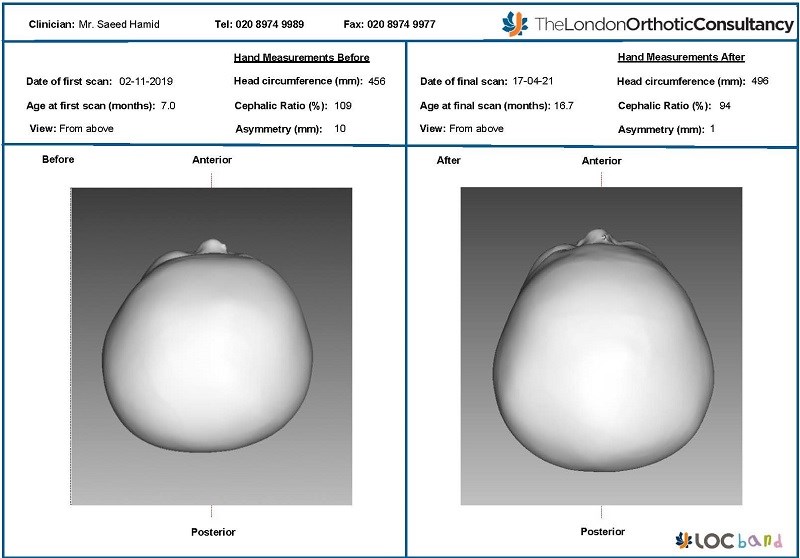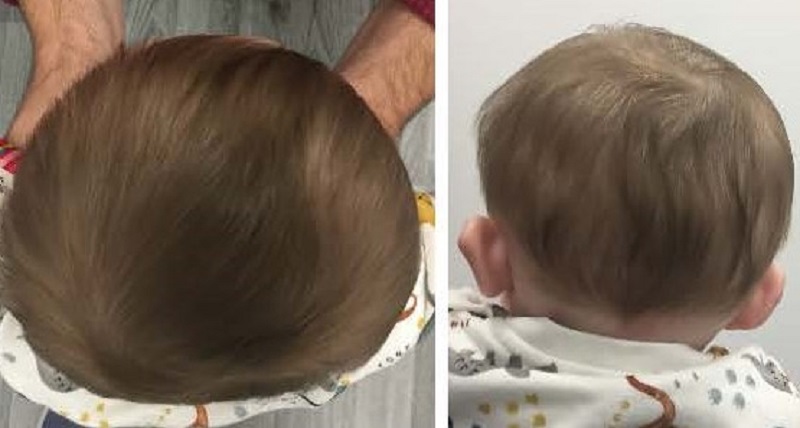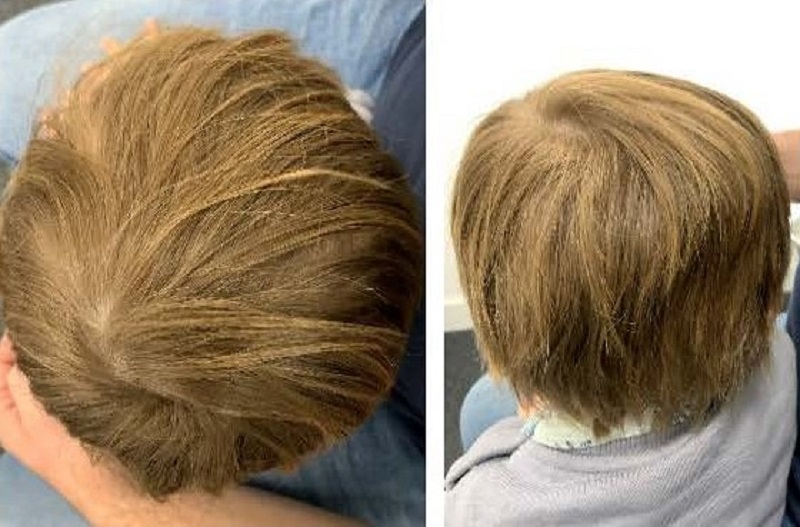
15 July 2021
When Claudia and Peter noticed their baby boy had an unusually flat head shape, they were naturally concerned. Worried about what the issue could mean in the future if left untreated, they decided that they needed to act while time was on their side.
“Looking back at photos of our boy, even when he was one month old, you can clearly see that his head was razor flat on one side,” mum Claudia recalls. “But we really started to become concerned at about three months. He was also experiencing severe gastric reflux, so our GP referred him to a cranial osteopath for that issue, and she agreed that his head shape was unusual.”
The couple decided to research treatment options for brachycephaly after discovering that such interventions were not available on the NHS. “We raised our concerns during post-natal checks and with our GP, but they took the view that it was likely to correct itself over time,” dad Peter says. “They encouraged us to increase ‘tummy time’ for our son (which we did) and to wait and see. We found LOC online, and we arranged to visit Saeed (Saeed Hamid, Orthotist at LOC), to see what might be possible. He took our son’s cranial measurements compared them against his cephalic index chart, which goes up to 108 with anything above 95 classed as severe brachycephaly. The cephalic ratio score was quite literally off the chart! Our boy measured at 109, with an asymmetry of 10mm. That visual illustration reassured us that our concerns were genuine.”
Peter and Claudia found themselves in a difficult position – one that will be familiar to many parents of babies with brachycephaly or plagiocephaly. “On the one hand, the NHS said that the condition would probably correct itself – but only time would tell,” says Claudia, “On the other hand, Saeed explained that we only had a short window of time for a LOCBand to be effective before the plates of our son’s skull hardened and the overall shape could not be altered. I remember our conversation after that first appointment. We needed to look ahead and think about the possible impact on our little boy as he grows up if we didn’t correct the brachycephaly. People tend to think of flat head as a cosmetic issue and, of course, we want our son to grow up feeling confident and not self-conscious, but, when you think about it, there are practical implications as well. For example, something as simple as buying him a well-fitting cycle helmet could potentially be difficult given the severity of his head shape. All things considered, we decided that we needed to take positive action and go ahead with the LOCBand treatment plan.”

Peter and Claudia recall the support that the LOC team offered them along what they knew might not be an easy path. “Saeed was very open about the fact that getting used to the helmet could be challenging for our little boy, especially during the first few weeks,” says Claudia. “He made sure we understood that there might be rubbing and red spots, or he might be uncomfortable at night or in hot weather. That was very helpful because we knew what to expect and so we were prepared to deal with it. Plus, of course, our son was growing all the time. Saeed was very accommodating when adjustments to the helmet were needed. At one point over Christmas, we were in Lincolnshire and we noticed that the LOCBand needed adjusting. Obviously, travelling from Lincolnshire to Kingston over Christmas would not be ideal! But Saeed was working in LOCs Cambridge Clinic, and so he was able to see us there and make the adjustments on the same day. He, and all of the LOC team, were always flexible and helpful when we needed support or urgent attention. In fact, some of the orthotists have had their babies in the same LOCband treatment. They really understand what this experience is like from a parent’s perspective.”
In total, their son wore the helmet for 9.5 months and upon their exit appointment (15 months on due to Covid), this lovely little boy has completed his LOCband treatment. Peter and Claudia are thrilled with the results. “At the start of the treatment, Saeed told us that we could expect the cephalic ratio to reduce by nine or ten points at most,” Peter explains. “In fact, it has reduced by 109 to 94. That’s a reduction of 15 points which is more than any of us hoped for. And his asymmetry has reduced from 10mm to just 1mm. We could have continued the treatment with a larger helmet. But, at that point, our son was at nursery, and we were so happy with the results that we felt it was a natural breakpoint for him and we were advised that the treatment is less effective the older a child is and given he was c.19 months by the time he outgrew the helmet, we did not feel that an additional helmet would be of significant benefit.”

Moving forward, the toddler’s parents are keen to ensure that other parents understand the options available if they are concerned about their baby’s head shape. “I would say to any parent who is worried that the most important thing to do is to get it checked out so that you can make an informed decision,” says Claudia. “And many parents are indeed worried. I got lots of enquiries on social media as I shared our journey. Yes, there is a cost, but for parents who are struggling financially, there is support out there – for example, from the charity Headstart4Babies. When we visited LOC there was no sales pitch or pressure – just honest, helpful advice and support. We’re very happy with the service we received from LOC and, most of all, we are delighted with the results!”
You can get an initial opinion from our orthotists using our online flat head diagnosis. It’s confidential and free, and we will respond to you within 24 hours. If we think your baby is showing signs of brachycephaly or plagiocephaly, we offer a free initial consultation for babies aged three months and upwards, where we can assess your baby’s head shape in more detail and advise you of your options as a parent.
This is very much dependent on how fast your baby is growing. The faster the growth, the more frequently your baby will be seen so that the helmet can be adjusted. In general, reviews will happen at two to four-week intervals.
The price of treatment covers:
Yes - All babies that have completed their course of treatment with us have achieved a measurable improvement in head shape. However, you don’t have to take our word for it.
Recent independent research conducted by a University Hospital in Germany has endorsed the treatment for babies with moderate or severe plagiocephaly.
A larger, retrospective study has just been published that found complete correction was achieved in 94.4% of babies treated with helmet therapy.
The results were conclusive: repositioning achieved acceptable correction in 77.1% of cases, but 15.8% were moved onto helmet therapy because re-positioning was not working. Meanwhile, 94.4% of the infants who started in the helmet-treated group achieved full correction, as did 96.1% of those who were transferred from the repositioning group into the helmet-treated group.
Further information can be found on our Plagiocephaly Research page.
If your baby has a temperature or a fever due to illness you must remove the band. The band can be put back on once the temperature has returned to normal.
The optimum age for treatment is between four and seven months.
This is because the skull is most malleable at this age and improvements to head shape tend to take less time and are more dramatic. That is not to say that helmet therapy should be ruled out if the baby is older than seven months. Routinely, babies up to the age of 16 months can be treated very successfully.
The cut off age is around 18 months when the fontanelles (soft spots on the head) are no longer malleable. As babies grow and develop at different rates, it is always worth checking if you are not sure. There have been cases where a baby’s fontanelles have not fused yet by the age of 18 months, who have achieved successful, but less-marked results with cranial remoulding therapy.
Torticollis is a condition in which a tight or shortened muscle in one side of the neck causes the head to tilt or turn to one side, resulting in the infant resting its head in the same position. In 2013, we analysed the data from all first appointments in our Kingston clinic and found that 20% of the babies examined had some kind of neck condition that was causing head immobility.
The clinics and clinicians that provide this treatment in the UK will have received similar training and experience. However, we are the only clinic that manufactures its own helmet and our clinicians are closely involved with the process for each individual helmet that we produce.
In addition, we do not restrict review appointments to a set number, we are extremely flexible and respond to individual parents' needs so that the best outcome can be achieved for each baby.
The LOCband is non-invasive and works by applying gentle, constant pressure over the areas of the baby’s skull that are most prominent while allowing unrestricted growth over the flattened areas. The band consists of a soft foam layer inside a thermoplastic shell. As the baby grows, the band will be adjusted frequently to gently guide the skull into a more symmetrical shape.